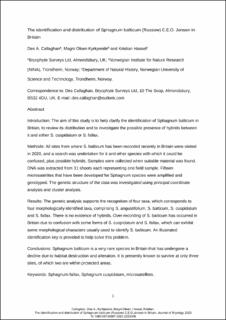The identification and distribution of Sphagnum balticum (Russow) C.E.O.Jensen in Britain
Peer reviewed, Journal article
Accepted version

Åpne
Permanent lenke
https://hdl.handle.net/11250/3085206Utgivelsesdato
2023Metadata
Vis full innførselSamlinger
- Publikasjoner fra CRIStin - NINA [2364]
- Scientific publications [1392]
Originalversjon
10.1080/03736687.2023.2223058Sammendrag
Introduction. The aims of this study were to help clarify the identification of Sphagnum balticum in Britain, to review its distribution, and to investigate the possible presence of hybrids between it and either S. cuspidatum or S. fallax. Methods. All sites at which Sphagnum balticum has been recorded recently in Britain were visited in 2020, and a search made for it and other species with which it could be confused, together with possible hybrids. Samples were collected when suitable material was found. DNA was extracted from 31 shoots, each representing one field sample. Fifteen microsatellites that have been developed for Sphagnum species were amplified and genotyped. The genetic structure of the data was investigated using principal coordinate analysis and cluster analysis. Results. The results of the genetic analysis support the recognition of four taxa, which corresponded to four morphologically identified taxa: Sphagnum angustifolium, S. balticum, S. cuspidatum and S. fallax. There was no evidence of hybrids. Over-recording of S. balticum has occurred in Britain due to confusion with some forms of S. cuspidatum and S. fallax, which can exhibit some morphological characters usually used to identify S. balticum. An illustrated identification key is provided to help solve this problem. Conclusions. Sphagnum balticum is a very rare species in Britain that has undergone a decline due to habitat destruction and alteration. It is presently known to survive at only three sites, of which two are within protected areas. Microsatellites; Sphagnum cuspidatum; Sphagnum fallax
